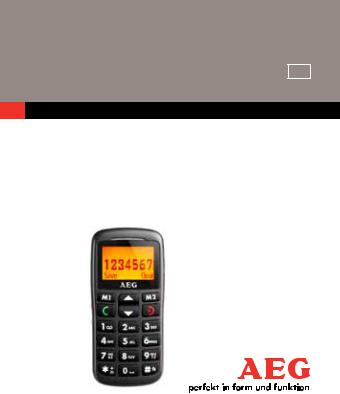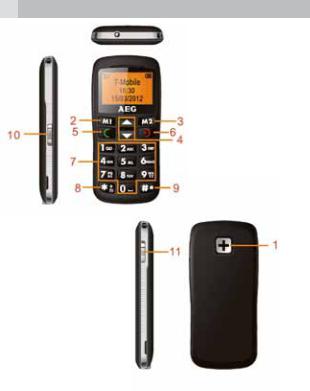AEG Voxtel M300 User Manual

USER GUIDE
UK
MOBILE
TELEPHONE
M300
V1

2

3
1 BECAUSE WE CARE
Thank you for purchasing this product. This product has been designed and assembled with utmost care for you and the environment. This is why we supply this product with a quick installation guide to reduce the number of paper (pages) and therefor save trees to be cut for making this paper. Thank you for supporting us to protect our environment.
UK
2 SAFETY AND PRECAUTIONS
When using your telephone, basic safety precautions should always be followed to reduce the risk of fire, electric shock and injury, including the following:
1.Switch off the phone in the vicinity of chemical plants, gas stations and other locations containing explosive objects.
2.When driving, please use the hands free calling device (purchased separately) to ensure safety. Please park the car at roadside for communication unless in emergency.
3.Switch off the phone when boarding an airplane and do not switch the phone on during the flight.
4.Be careful when using the mobile phone in the vicinity of such devices as pacemakers, hearing aids and other electro-medical equipment, which may be interfered by the mobile phone.
5.Never attempt to disassemble the phone by yourself.
6.Do not recharge the phone without battery being installed.

4
7.Charge the phone in well-ventilated environment and keep away from inflammable and high explosive articles.
8.To avoid demagnetization, keep the handset away from magnetic substances, such as magnetic discs or credit cards.
9.Keep the phone away from liquid. If soaking or erosion occurs, take the battery out and contact the supplier.
10.Avoid using the phone in too high or too low temperature environments. Never leave the phone exposed under direct sunlight, in high humidity or in a dusty environment.
11.Do not use liquid or a damp cloth with strong detergents to clean the handset.
2.1Charging your battery
Your device is powered by a rechargeable battery. The full performance of a new battery is achieved only after two or three complete charge and discharge cycles. The battery can be charged and discharged hundreds of times but it will eventually wear out. When the talking and standby time is noticeably shorter than normal, please replace the battery. Use only approved batteries and recharge your battery only with approved chargers designated for this device.
If a replacement battery is being used for the first time or if the battery has not been used for a long period, it may be necessary to connect the charger, disconnect it and then reconnect it to begin charging the battery.
Unplug the charger from the electrical plug and the device when not in use. Do not leave a fully charged battery

5
connected to a charger, since overcharging may shorten its lifetime. If left unused, a fully charged battery will lose its charge over time.
If the battery is completely discharged, it may take a few minutes before the charging indicator appears on the display or before any calls can be made.
Use the battery only for its intended purpose. Never use any charger or battery that is damaged.
Do not short-circuit the battery. Accidental short-circuiting will occur when a metallic object such as a coin, clip or pen causes direct connection of the positive (+) and negative (-) terminals of the battery. This might happen, for example, when you carry a spare battery in your pocket or purse. Short-circuiting the terminals may damage the battery or the connecting object.
Leaving the battery in hot or cold places, such as in a closed car in summer or winter conditions, will reduce the capacity and lifetime of the battery. A device with a hot or cold battery may not work temporarily, even when the battery is fully charged. Battery performance is particularly limited in temperatures well below freezing.
Do not dispose of batteries in a fire as they may explode. Batteries may also explode if damaged. Dispose of batteries according to local regulations. Please recycle when possible. Do not dispose as household waste.
UK

6
Note:
Actual operation time of the battery varies according to operation mode, network settings and call settings.
Note:
•To ensure safety, do not change the parts and accessories of the battery by yourself or take off the battery shell.
•We suggest you only use the original battery supplied with your phone to avoid any damage to your phone.
• The temperature range for charging the phone is 0°C - 40¨C. Do not charge the battery in too high or too low temperatures.
•Do not use the mobile phone during charging.
•Please don’t keep charging for a long time. Pull out the charger after the battery is fully charged.
2.2Further safety information
The unit and the accessories can contain small parts. Keep them out of the reach of small children.
2.3Operating environment
Remember to follow any particular rules that may apply wherever you happen to be and always turn off the unit whenever its use is forbidden, or it can cause interference or danger. Only use the units in its normal user position.
This unit complies with guidelines for radiation when it is used either in a normal position against your ear, or when it is at least 2.2 cm from your body. If the unit is carried close to

7
your body in a case, belt holder or other holder, these should not contain any metal and the product should be placed at the distance from your body specified above.
Parts of the unit are magnetic. The unit can attract metal object. Do not keep credit cards or other magnetic media near the unit, as information stored on them can be erase.
2.4Medical units
The use of equipment that transmits radio signals, e.g. mobile phones, can interfere with insufficiently protected medical apparatus. Consult a doctor or the manufacturer of the apparatus to determine if it has adequate protection against external radio signals, or if you have any question. Wherever there is notices to forbidden use of mobile phone, you should comply. Hospitals and other health care facilities sometimes use equipment that can be sensitive to external radio signals.
2.5Pacemaker
Pacemaker manufacturers recommend a distance at least 15 cm. between a mobile phone and a pacemaker to avoid the risk of interference with the pacemaker. These recommendations are in accordance with independent research and recommendations from Wireless Technology Research. People with pacemakers should:
•not carry the unit in a breast pocket
•hold the unit against the ear on the opposite side from the pacemaker to reduce the risk of interference
UK

8
If you suspect that there is a risk of interference, turn off the unit and move it further away.
2.6Hearing aids
Some digital wireless units can cause interference to some hearing aids. Contact your operator in case of interference.
2.7Vehicles
Radio signals can affect electronic systems in motor vehicles (e.g. electronic fuel injection, ABS brakes, automatic cruise control, air bag systems) that have been incorrectly installed or are inadequately protected. Contact the manufacturer or its representative for more information about your vehicle or any additional equipment.
Do not keep or transport flammable liquid gases or explosives together with the unit or its accessories. For vehicles equipped with air bags: remember that air bags fill with air with considerable force.
Do not place objects, including fixed or portable radio equipment in the area above the airbag or the area where it might expand. Serious injuries may be caused if the mobile phone equipment is incorrectly installed and the airbag fills with air.
2.8Areas with explosion risk
Always turn off the unit when you are in an area where there is a risk of explosion and follow all signs and instructions. An explosion risk exists in the places that include areas where

9
your normally requested to turn off your car engine. Within such an area, sparks can cause explosion or fire which can lead to personal injuries, even death.
Turn off the unit at filling stations i.e. near petrol pumps and garages.
Follow the restrictions that are in force on the use of radio equipment near places where fuel is stored and sold, chemical factories and places where blasting is in progress.
Areas with risk for explosion are often – but not always – clearly marked. This also applies to below decks on ships: the transport or storage of chemicals; vehicles that use liquid fuel (such as propane or butane); areas where the air contains chemicals or particles, such as grain, dust or metal powder.
2.9Emergency calls
Important!
Mobile phones use radio signals and the mobile phone network. This means that connection in all circumstances cannot be guaranteed.
Therefore you should never rely solely on a mobile phone for very important calls such as medical emergencies.
2.10Certification information (SAR)
This model meets international guidelines for exposure to radio waves. Your mobile device is a radio transmitter and receiver. It is designed not to exceed the limits for exposure to radio waves recommended by international guidelines.
UK

10
These guidelines were developed by the independent scientific organization ICNIRP and include safety margins designed to assure the protection of all persons regardless of age and health.
The guidelines use a unit of measurement known as the Specific Absorption Rate, or SAR. The ICNIRP SAR limit for mobile devices used by the general public is 2.0 W/kg.
As SAR is measured utilising the device’s highest transmitting power, the actual SAR of the device while operating is typically below the above indicated level.
This is due to automatic changes to the power level of the device to ensure it only uses the minimum level requested to reach the network.
The World Health Organization has stated that present scientific information does not indicate the need for any special precaution for the use of mobile devices. They note that if you want to reduce your exposure then you can do so by limiting the length of calls or using a “hands-free” device to keep the mobile phone away from the head and body.
3 BOX CONTENT
In the box you will find:
•1 Mobile Phone
•1 Mains power adapter
•1 Charging cradle

11
•1 Rechargeable batterypack
•1 User guide
Keep the packing materials in a safe place in case you later need to transport the device.
UK
4 ENTER TEXT
When you add a contact to the phonebook or write an SMS you have to use the numeric keys to enter text.
To select the input mode you press the #-key during the entering of the text.
You can select following input mode : ABC,abc and 123.
ABC/abc input : press the numeric keys 2 to 9 to enter the letters. Each key has 3 or 4 characters. You need to press the key 1 time for first character, twice for second character and so on.
For example to enter : Tom : press 8 key 1 time, 6 key 3 times, 6 key 1 time.
ABC: to use capital letters and abc to use small letters
Use the * key to select symbols and 0 key for space.
Select 123 input mode to enter only numbers.
To delete a charater: Press the right softkey one time or press and hold right softkey to delete all characters.
To move the cursor left or right : Press the up /down key.

12
5 GETTING TO KNOW YOUR PHONE
5.1Keys and parts (see P1)
# |
|
Meaning |
|
1 |
SOS Key |
• Press and hold to activate SOS |
|
call. |
|||
|
|
||
2 |
Left Soft Key |
M1. |
|
3 |
Right Soft |
M2. |
|
Key |
|
||
|
|
||
|
|
Menu |
|
4 |
Up and |
• Press UP to enter the menu. |
|
• Press DOWN to open the |
|||
Down Key |
|||
|
|
phonebook |
|
|
|
• Increase or decrease the volume. |
|
|
|
Dials a phone number and |
|
5 |
Talk key |
answers a call. |
|
• In idle: press to show the most |
|||
|
|
||
|
|
recently dialed numbers . |
|
|
|
• Ends or rejects a call; |
|
6 |
End key |
• Long press it to power on or off |
|
the phone. |
|||
|
|
• In menu : press it to exit to the |
|
|
|
idle screen.. |
